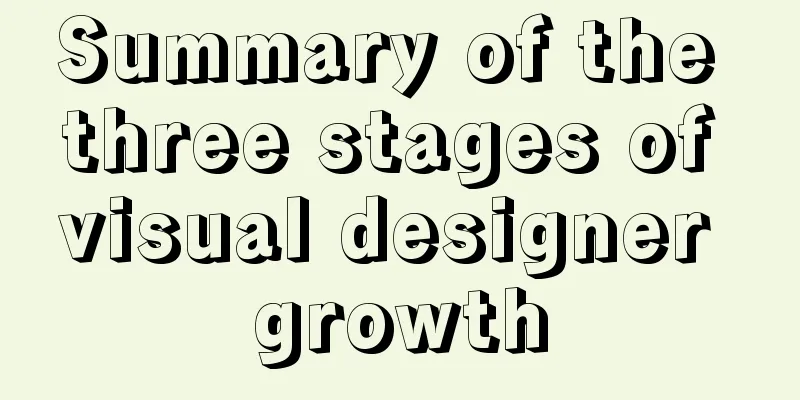Summary of the three stages of visual designer growth

|
Many people have read this book: "Grow as a graphic designer", and I have also read the original PDF version. Although this article has little to do with what this book talks about, I use this book as a prologue to actually say that visual designers need to think seriously about themselves at different stages. The threshold for doing visual design is very low now. “Most designers don’t improve through reflection.” This is the sentence that left the deepest impression on me from the first supervisor in my career, and I would like to share it with you. Designing subconsciously or consciously in a specific project is the main benchmark for me to distinguish these three stages, and it is also my own accumulation of experience. Since I have only been in this business for a year and a half, these summaries are bound to have some flaws. Please feel free to point out any shortcomings. Stage 1: Subconscious Design I think most people’s process and experience of learning visual design are similar, which is the result of the openness and sharing spirit of the Internet. As a novice, it is natural for me to read some theoretical books on visual design, classic cases, and browse a large number of works by mature designers on the Internet. When practicing, I will also start with copying, and I will unconsciously like a certain style, even down to certain details (such as rounded corners). The impression brought by the image will naturally be more profound than the theory in the book. Therefore, in the first stage, visual designers often create designs based on the many image fragments in their minds. Why is it said that this stage is designed subconsciously? The criteria that really determine the quality of a design, such as inactive symmetry and active unsymmetry of the layout, clever use of negative space, the use of complementary colors/intermediate colors/adjacent colors, the use of font stackers, etc., are implemented unconsciously by novices when they are designing. This knowledge is often browsed by novices when reading books on visual design theory, but it is not enough to form a deep impression and become a standard to guide design (because there is not enough practical accumulation). As mentioned earlier, novices will design based on the image fragments in their minds. These image fragments are good design fragments accumulated during the daily learning process, and they include some standards in visual design. A novice designer will indirectly apply these standards when "imitating", but at this time, he is subconscious. Stage 2: Conscious Design It seems that the second stage is reached naturally. This is indeed the case. With the accumulation of experience and knowledge, and even re-reading books on visual design theory, designers will gradually begin to consciously apply these theories to their creations. But it is not easy to reach this stage. In fact, it is what we usually call "opening up". Some designers may spend their entire lives without being able to use these design theories to guide their designs, and they always "follow their feelings". Moreover, it is difficult to eliminate those image fragments in the mind in a short period of time. As far as my own experience is concerned, during the design process, although I always remind myself to consciously practice theoretical knowledge, I will start to imitate the images in my mind as I go along. This stage is painful and long, but it is definitely meaningful and valuable. Because a mature visual designer must learn to use his own ideas to guide his design, rather than "impressions". After your own abilities have improved to a certain level, the impression of images will hardly help you anymore and will instead restrict your design. Because at this point you will have analyzed each project in detail, identified the causes and consequences behind each requirement, and imagined the viewer's reaction after seeing each of your designs; and although the image impression contains a lot of useful theoretical information, it is also mixed with other information that interferes with your judgment. After all, each project is different. So at this point you have to force yourself to start thinking. And thinking is the sign of a designer’s maturity. This doesn’t just apply to visual designers. The third stage: seeing mountains as mountains again, and seeing water as water again I believe that after watching the first two stages, everyone will say that this is very similar to "seeing a mountain as a mountain". That’s right, some principles are applicable everywhere. The same is true for the third stage of designers, when they return to their subconscious when designing. I am still a novice designer, but I have learned a lot from the mature designers around me, and through these studies I have also figured out their state when designing. I prefer to call the visual design at this time: art direction. Design theory only comes out of their mouths when they evaluate other people's designs. It can be said that they are already familiar with most of the good design standards mentioned above, and can even subvert some of them to achieve amazing designs. When they are doing the specific design, they often make a detail piece to determine the artistic style of the entire project. For example, the design of 26000 vodka is natural as a whole, and the inspiration comes from the texture of vodka ice cubes and bottles. It seems that the entire website (whether it is flash or basic html) does not use very dazzling processing, but as you browse the website, you will appreciate its uniqueness. Appreciation Visual designers have different perspectives on appreciating design at different stages. Designers at the first stage will focus on the details of local design; designers at the second stage will learn how good designers are formed and why they do so; designers at the third stage usually take a look or two to appreciate the temperament and overall feeling behind the design. Finally, as a half-baked visual designer, I strongly recommend everyone to read a book, "The elements of Graphic design", which is the best design theory book I have seen so far. It would be best if you could watch the original version (according to Gundam, the Chinese translation is a bit unreliable). At the same time, the About Me column on my website has other basic books I recommend, which are also the secrets that can greatly improve your skills after reading them. |
<<: Use js in html to get the local system time
>>: Detailed explanation of the difference between run/cmd/entrypoint in docker
Recommend
How to block and prohibit web crawlers in Nginx server
Every website usually encounters many non-search ...
JavaScript+html to implement front-end page sliding verification
This article shares the specific code of JavaScri...
React implements double slider cross sliding
This article shares the specific code for React t...
Detailed steps to install web server using Apache httpd2.4.37 on centos8
Step 1: yum install httpd -y #Install httpd servi...
Detailed explanation of the example of exporting data from a specified table in MySQL
Detailed explanation of MySQL exporting data from...
JavaScript to achieve tab switching effect
This article shares the specific code of JavaScri...
How to implement Docker to dynamically pass parameters to Springboot projects
background Recently, some friends who are new to ...
SQL method for calculating timestamp difference
SQL method for calculating timestamp difference O...
Basic knowledge: What does http mean before a website address?
What is HTTP? When we want to browse a website, w...
Ansible automated operation and maintenance deployment method for Linux system
Ansible is a new automated operation and maintena...
How to get the size of a Linux system directory using the du command
Anyone who has used the Linux system should know ...
Vue+express+Socket realizes chat function
This article shares the specific code of Vue+expr...
Summary of commonly used performance test scripts for VPS servers
Here is a common one-click performance test scrip...
Measured image HTTP request
Please open the test page in a mainstream browser...
Three methods of automatically completing commands in MySQL database
Note: The third method is only used in XSell and ...









